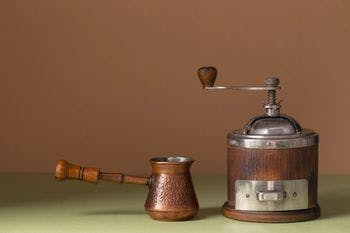
How to Make Arabic Coffee At Home? (Step-by-Step)

If you are a coffee lover, you must have heard about Arabic coffee. No! Here I am not talking about the coffee made from the Arabica beans. Arabic coffee is a brewing ritual that exceeds mere beverages. It is an authentic coffee renowned for its wonderful taste and cultural significance.
The aromatic blend, the precise preparation, and the warm hospitality signify the integral Middle Eastern traditions. But wait what if I tell you, you can bring this cherished tradition into your home.
Yes! In this blog, I will aid you in mastering the art of making Arabic coffee with a step-by-step guide. So get ready to infuse your space with the inviting aroma of freshly brewed coffee with a time-honored cultural practice. Let's dive in.
What is Arabic coffee?
Arabic coffee, also known as "Qahwa" or "Gahwa" in Arabic, is not just a caffeine fix; it reflects Middle Eastern hospitality and culture.
Well known for its authentic taste, this amazing beverage stands out and is characterized by its unique preparation method, distinct flavor profile, and the cultural significance it holds.
Authentically made with lightly roasted coffee beans, and cardamom, and topped with spices like cloves, this brew reflects the essence of Arabian heritage.
Different coffee makers used to prepare Arabic coffee
Arabic coffee, the specialty of Middle Eastern traditions, is brewed using unique and culturally significant coffee makers. The most renowned of these is the "Dallah" – a distinctive long-necked coffee pot that boasts a wide base, representing the essence of Arabian hospitality.
1) Dallah
The Dallah is an iconic symbol, with its long spout and elaborate design. It's not just a coffee pot; it's a reflection of cultural identity and a centerpiece for communal gatherings.
2) Briki
Briki, with its small size and long handle, is favored in other Middle Eastern cultures. It adds its unique appeal to the coffee-making ritual.
3) Ibrik
Often used interchangeably with Briki, the Ibrik is a small, long-handled pot that has a history dating back centuries. Its design and functionality have stood the test of time.
Things you need to make Arabic coffee at home
Ingredients needed
- 2 tbsps of finely ground coffee
- 1 tbsp of ground cardamom
- 1/4 cup of water
- Sugar (as per taste)
Equipment needed
- Small pot or Turkish briki
- Small coffee cup or demitasse
- Strainer (optional)
- Coffee and spice grinder (optional)
How to make Arabic coffee at home?
Step 1: Set up your coffee pot
Start by pouring water and sugar into a saucepan or briki. Let it heat for a while over medium heat until it reaches a certain temperature. The sugar is optional, you can add or skip it as per your taste.
Step 2: Mix coffee and cardamom
Once it’s hot enough, add coffee and cardamom to the mixture. Make sure the coffee is finely ground. The grind size is vital to achieve the perfect balance of flavors during brewing. Cardamom adds a special, aromatic touch to the coffee.
Step 3: Let the mixture simmer
Stir the mixture and let it simmer for a few minutes. The slow brewing process extracts the rich flavors from the coffee beans.
Step 4: Place the briki over the heat source
Again put the briki over the heat source, until it's foamy enough. Once done, remove it from the heat and let the foam settle. Repeat this at least twice to achieve the right foam texture.
Your coffee is ready. Pour it slowly and savor the unique blend of flavors and the cultural experience it offers.
How to serve Arabic coffee?
1) Use traditional cups (Finjaan)
Arabic coffee highlights the Arab’s cultural beauty. To make it delightful and wholesome, use small, handleless cups called “Finjaan”. These cups are adorable and hold a small amount of coffee, inspiring guests to sip it slowly and enjoy the intricate flavors.
2) Use a serving tray
You can place the Finjaan coffee cups on a beautifully adorned serving tray. The tray portrays elegance and makes it easier to carry multiple cups.
3) Pair it with dates or sweets
You can pair authentic Arabic coffee with dates or traditional Middle Eastern sweets.
4) Follow the right-hand gesture
Make sure you use your right hand to serve or receive the coffee. This gesture is considered a sign of respect and cultural etiquette.
5) Consider the three rounds of tradition
Arabic coffee is often sipped in three rounds. The first cup is considered strong, the second is medium, and the third is light. It's not compulsory, guests can choose to stop or continue when they're full.
6) Obey the pouring etiquette
When you pour Arabic coffee, do it from a low height. It helps the coffee to cool and showcases the host's generosity.
Wrapping up
Here, I have got you covered with the step-by-step methods to make Arabic coffee at your home.
In conclusion, Arabic coffee is not just a delightful cup but a cultural journey that surpasses ordinary coffee.
From the careful preparation to the aromatic blend, every step is infused with Middle Eastern traditions that bring warmth and authenticity to the experience. So, pick your ingredients, brew your coffee, and enjoy the authentic Arab delight.
FAQs
1) Where did Arabic coffee come from?
Arabic coffee, also called Qahwa, originated in the Arabian Peninsula, with historical roots in Yemen.
2) In which countries Arabic coffee is commonly brewed?
Arabic coffee is commonly used in countries across the Middle East, including Saudi Arabia, Yemen, Oman, and the United Arab Emirates.

I am a coffee aficionado based in Seattle. I have devoted my passion and expertise to perfecting the art of home coffee brewing. I became known for my exquisite pour-over and espresso creations. I source coffee beans from local roasters and explores ...



